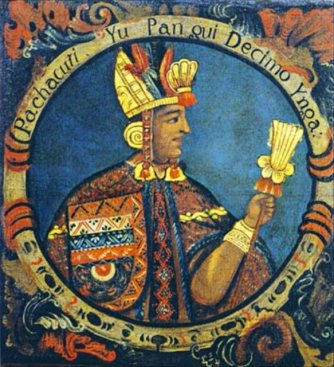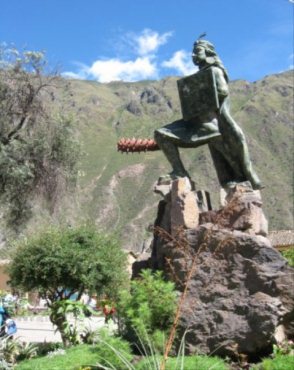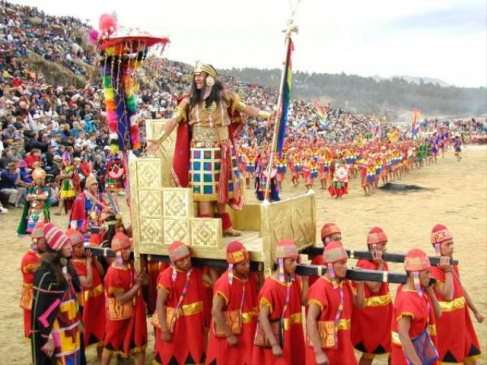History of the Incas

|
History of the Incas
The Inca Empire was an empire centered in what is now Peru from AD 1200 to AD 1533. Over that period, the Inca used conquest and peaceful assimilation to incorporate in their empire a large portion of western South America, centered on the Andes mountain ranges. The Inca Empire proved short-lived: by AD 1533, Atahualpa, the last Inca emperor, called a Sapa Inca, was killed on the orders of the conquistador Francisco Pizarro, marking the beginning of Spanish rule. He used the capture to gain gold as a ransom. Over four months, almost eight tonnes of gold was collected. Pizarro was supposed to let the ruler of the Incas free once he got his gold, but instead had him strangled in public. Quechua name: Tawantin Suyu which
can be translated The Four
Regions or The Four United
Regions. Before the Quechua
spelling reform it was written in Spanish as Tahuantinsuyo. Tawantin is a group of four things
(tawa "four" with the suffix
-ntin which names a group);
suyu means "region" or
"province". The empire was divided into four suyus, whose corners met at the
capital, Cusco (Qosqo), in
modern-day Peru. The official language of the empire was Quechua, although over seven hundred local languages were spoken. The Inca
leadership encouraged the worship of their gods, the foremost of which was Inti, the sun
god. Origin stories: The Inca had four types of origin myths. In one, Tici Viracocha of Colina de las Ventanas in Pacaritambo sent forth his four sons and four daughters to establish a village. Along the way, Sinchi Roca was born to Manco and Ocllo, and Sinchi Roca is the person who finally led them to the valley of Cuzco where they founded their new village. There Manco became their leader and became known as Manco Capac.In another origin myth the sun god Inti ordered Manco Capac and Mama Ocllo to emerge from the depths of Lake Titicaca and found the city of Cuzco. They traveled by means of underground caves until reaching Cuzco where they established Hurin Cuzco, or the first dynasty of the Kingdom of Cuzco. In the third origin myth, an Inca sun god told his wife that he was lonely. She proposed that he create a civilization to worship him and keep him company. He saw this as a wise plan and carried it out. The Inca were born from Lake Cuzco and populated the Andes and worshiped their sun god. In the last origin myth, Manco Capac who was the son of the sun, and his sister Mama Occlo, the daughter of the moon, were sent by the sun to look for a place to build an empire. They were to tell when they were at the right place by carrying a special rod with them at all times. Wherever the rod sank into the ground, this was where they were to create a new city. The rod sank into the ground in Cuzco. The knowledge of these myths is due to oral tradition, since the Incas could not write. There probably did exist a Manco Capac who became the leader of his tribe. The archeological evidence seems to indicate that the Inca were a relatively unimportant tribe until the time of Sinchi Roca, also called Cinchi Roca, who is the first figure in Inca mythology whose existence can be supported historically. The Incas were destroyed by the Spanish making it hard to find helpful clues about the Incas. The Inca people began as a tribe in the Cuzco area around the 12th century AD. Under the leadership of Manco Capac they formed the small city-state of Cuzco Quechua Qosqo). In 1438 AD, under the command of Sapa Inca (paramount leader) Pachacuti, whose name literally meant "world-shaker", they began a far-reaching expansion. The land Pachacuti conquered was about the size of the Thirteen Colonies of the United States in 1776, and consisted of nearly the entire Andes mountain range.  Pachacuti reorganised the kingdom of Cuzco into an empire, the
Tahuantinsuyu, a federalist
system which consisted of a central government with the Inca at its head
and four provincial governments with strong leaders: Chinchasuyu (NW), Antisuyu (NE), Contisuyu (SW), and Collasuyu (SE). Pachacuti is also thought to have built Machu
Picchu, either as a family home or as a guarded retreat. Pachacuti
would send spies to regions he wanted in his empire who would report back on
their political organization, military might and wealth. He would then send
messages to the leaders of these lands extolling the benefits of joining his
empire, offering them presents of luxury goods such as high quality textiles and
promising that they would be materially richer as subject rulers of the Inca.
Most accepted the rule of the Inca as a fait
accompli and acquiesced peacefully. The ruler's children would then be
brought to Cuzco to be taught about Inca administration systems, then return to
rule their native lands. This allowed the Inca to indoctrinate the former
ruler's children into the Inca nobility, and, with luck, marry their daughters
into families at various corners of the empire. It was traditional for the Inca's son to lead the army; Pachacuti's
son Túpac
Inca began conquests to the north in 1463 and continued them as Inca
after Pachucuti's death in 1471. His most important conquest was the Kingdom of
Chimor, the Inca's only serious rival for the coast of Peru. Túpac Inca's
empire stretched north into modern day Ecuador and Colombia. Túpac Inca's son
Huayna
Cápac added significant territory to the south. At its height,
Tahuantinsuyu included Peru and Bolivia, most of what is now Ecuador, a large portion of modern-day Chile and extended into corners of Argentina and Colombia. Tahuantinsuyu was a patchwork of languages, cultures and peoples.
The components of the empire were not all uniformly loyal, nor were the local
cultures all fully integrated. For instance, the Chimú used money in their commerce, while the Inca empire as a whole had
an economy based on exchange and taxation of luxury goods and labour (it is said
that Inca tax collectors would take the head lice of the lame and old as a symbolic tribute). The portions of the Chachapoya that had been conquered were almost openly hostile to the Inca and
the Inca nobles rejected an offer of refuge in their kingdom after their
troubles with the Spanish. Spanish conquest and Vilcabamba: Spanish conquistadors led by Francisco
Pizarro explored south from Panama, reaching Inca territory by 1526. It was
clear that they had reached a wealthy land with prospects of great treasure, and
after one more expedition (1529), Pizarro traveled to Spain and received royal
approval to conquer the region and be its viceroy. At the time they returned to
Peru, in 1532, a war of succession between Huayna Capac's sons Huascar and Atahualpa and unrest among newly-conquered territories and perhaps more
importantly, smallpox which had spread from Central America had considerably weakened the
empire. Pizarro did not have a formidable force; with just one hundred and
eighty men, one cannon and only twenty seven horses, he often needed to talk his
way out of potential confrontations that could have easily wiped out his party.
Their first engagement was the battle
of Puná, near present-day Guayaquil, Ecuador; Pizarro then founded the city of Piura in July 1532. Hernando
de Soto was sent inland to explore the interior, and returned with an
invitation to meet the Inca, Atahualpa, who had defeated his brother in the
civil war and was resting at Cajamarca with his army of eighty thousand troops. Pizarro met with the Inca, who had brought only a small retinue, and
through interpreters demanded that he convert to Christianity. A widely disputed
legend claims that Atahualpa was handed a Bible and threw it on the floor, the
Spanish supposedly interpreted this action as adequate reason for war. Though
some chroniclers suggest that Atahualpa simply didn't understand the notion of a
book, others portray Atahualpa as being genuinely curious & inquisitive in
the situation. Regardless, The Spanish attacked the Inca's retinue (see
Battle
of Cajamarca), capturing Atahualpa. Atahualpa offered the Spaniards enough gold
to fill the room he was imprisoned in, and twice that amount of silver. The
Incas fulfilled this ransom, but Pizarro refused to release the Inca. During
Atahualpa's imprisonment Huascar was assassinated. The Spanish maintained that
this was at Atahualpa's orders; this was one of the charges used against
Atahualpa when the Spanish finally decided to put him to death, in August
1533. The Spanish installed his brother Manco Inca Yupanqui in power; for some time Manco cooperated with the Spanish, while the Spanish fought to put down resistance in the north. Meanwhile an associate of Pizarro's, Diego de Almagro, attempted to claim Cusco for himself. Manco tried to use this intra-Spanish feud to his advantage, recapturing Cusco (1536), but the Spanish retook the city. Manco Inca then retreated to the mountains of Vilcabamba, where he and his successors ruled for another thirty six years, sometimes raiding the Spanish or inciting revolts against them. In 1572 the last Inca stronghold was discovered, and the last ruler, Túpac Amaru, Manco's son, was captured and executed, bringing the Inca empire to an end.  After the Spanish conquest: After the fall of Tahuantinsuyu, the new Spanish rulers brutally
repressed the people and their traditions. Many aspects of Inca culture were
systematically destroyed, including their sophisticated farming system. The
Spanish used the Inca mita (mandatory public service) system to literally work the people to
death. One member of each family was forced to work in the gold and silver
mines, the foremost of which was the titanic silver mine at Potosí. When one family member died, which would usually happen within a
year or two, the family would be required to send a
replacement. The major languages of the empire, Quechua and Aymara, were employed by the Catholic
Church to evangelise in the Andean region. In some cases, these languages were taught to peoples who
had originally spoken other indigenous languages. Today, Quechua and Aymara
remain the most widespread Amerindian
languages. The legend of the Inca has served as inspiration for resistance
movements in the region. These include the 1780 rebellion led by Tupac
Amaru II against the Spanish, as well as contemporary the guerrilla movements Túpac
Amaru Revolutionary Movement (MRTA) and Sendero
Luminoso in Peru and Tupamaros in Uruguay. ALL IN ALL AMAZING TO STAND WHERE THEY STOOD AND BE WOWED AS THEY
WERE
A PHENOMENAL RACE FULL OF MYSTERY AND
CONJECTURE. |
